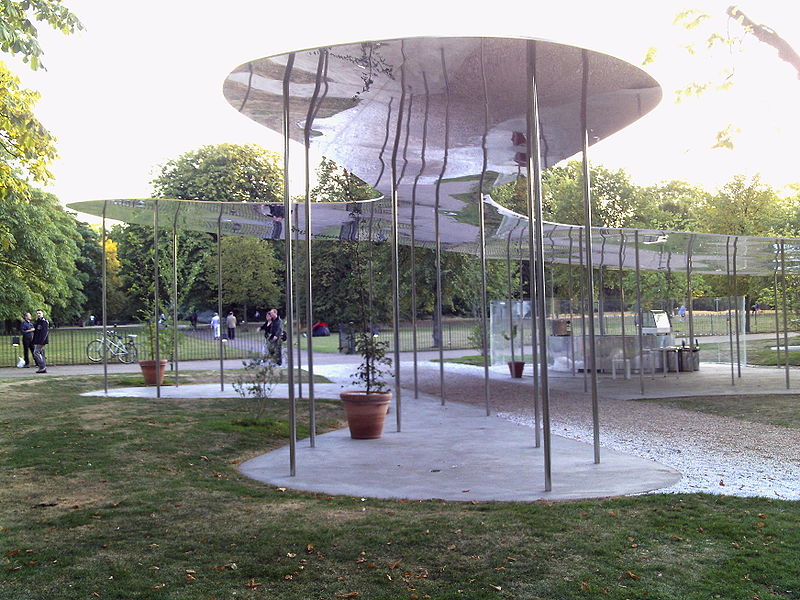Carine DeBenedittis


Location: London, UK
Date: 2009
Material: aluminum, other metals
Image link (1): https://commons.wikimedia.org/wiki/File:Serpentine_Gallery_2009_Pavilion.JPG
Image link (2): https://library.artstor.org/#/asset/AWSS35953_35953_29401333
This Serpentine Gallery Pavilion from 2009 exhibits many of the same features as the Koga Park Café. For example, this structure consists of a thin roof supported by very slender columns, giving it a weightless, delicate quality. Additionally, there are no walls or partitions at all, completely opening the space up to the surrounding park and making it possible to see straight through it on all sides. This also allows for variability in how the space might be used. Much like the Koga Park Café, this pavilion has a mirrored metallic roof. As seen in the second image, this surface can make it difficult to even see the structure because of how reflective it is of the park and sky around it. This accomplishes a different kind of transparency; even though there is a solid barrier blocking the view, the type of material used helps it blend in with its environment so well that it gives the sense that one is seeing through it. Traditional Japanese architecture also often made use of materials to blend in with the environment. Wood was commonly used because it is a natural material that evokes a connection to the trees around the building. Although Sejima’s contemporary designs are visually very different from traditional architecture, the creative use of materials to connect with nature is found in both. This quality in the Serpentine Gallery Pavilion is furthered by the unique shape of its roof. While the Koga Park Café’s roof is a rigid, rectangular shape, the pavilion has a more haphazard, organically shaped roof that resembles a cloud with natural, curved edges.
Thank you for your insightful analysis of the Serpentine Gallery Pavilion from 2009 and its similarities to the Koga Park Café. It’s fascinating to observe how both structures showcase a weightless and delicate quality through thin roofs and slender columns. The absence of walls or partitions, allowing an open and transparent space, is a remarkable feature that adds to their versatility. The mirrored metallic roof of the pavilion, as seen in the second image, creates a unique kind of transparency by blending seamlessly with the surroundings. This clever use of materials to connect with nature resonates with the traditional Japanese architecture’s emphasis on incorporating natural elements like wood. Although visually distinct, both Sejima’s contemporary designs and traditional architecture share a common thread of integrating materials with the environment. Additionally, the organic shape of the pavilion’s roof, resembling a cloud with curved edges, adds a touch of whimsy and further enhances its connection to nature. Overall, these architectural marvels exemplify the harmony between modernity and nature, capturing the essence of innovative design while paying homage to tradition.